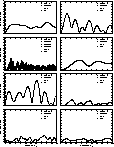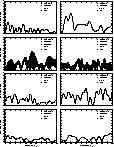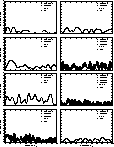We have established nonvariability for 24 ![]() Bootis candidate
stars with an upper limit of typically 3mmag, of which 11 stars are placed
within the instability strip, based on the calibration in the
Strömgren system.
If this evidence can be confirmed it would mean that at least 50% of
all
Bootis candidate
stars with an upper limit of typically 3mmag, of which 11 stars are placed
within the instability strip, based on the calibration in the
Strömgren system.
If this evidence can be confirmed it would mean that at least 50% of
all ![]() Bootis stars
inside the instability strip are pulsating.
Frequencies and amplitudes connect them with
Bootis stars
inside the instability strip are pulsating.
Frequencies and amplitudes connect them with ![]() Scuti stars.
For nearly solar abundant stars the percentage
of variability is significantly less, suggesting that a low
metallicity influences the instability behavior of stars.
Models have to be developed taking into account the abundance pattern
of
Scuti stars.
For nearly solar abundant stars the percentage
of variability is significantly less, suggesting that a low
metallicity influences the instability behavior of stars.
Models have to be developed taking into account the abundance pattern
of ![]() Bootis stars. Asteroseismic tools should make it possible to
investigate the stellar interior and evolutionary status
of
Bootis stars. Asteroseismic tools should make it possible to
investigate the stellar interior and evolutionary status
of ![]() Bootis stars. This would significantly improve the knowledge of
astrophysical parameters and
help to establish theories explaining the
Bootis stars. This would significantly improve the knowledge of
astrophysical parameters and
help to establish theories explaining the ![]() Bootis phenomenon.
Further observations are needed to
improve the statistics on the pulsation behavior of this group.
Photometric time series (ground based or from space) of well established
members could help to confirm the ratio of pulsating and constant stars
as well as decrease the level for nonvariability.
Bootis phenomenon.
Further observations are needed to
improve the statistics on the pulsation behavior of this group.
Photometric time series (ground based or from space) of well established
members could help to confirm the ratio of pulsating and constant stars
as well as decrease the level for nonvariability.
Acknowledgements
This research was carried out within the working group Asteroseismology-AMS with
funding from the Fonds zur Förderung der wissenschaftlichen Forschung (project
S7303-AST) and the Hochschuljubiläumsstiftung der Stadt Wien (project
![]() Bootis Sterne). GH and EP
acknowledge partial financial support by the Austrian Zentrum für
Auslandsstudien.
We want to thank our referee, Dr.Renson, for critical and helpful comments.
Use was made of the Simbad database, operated at CDS,
Strasbourg, France.
Bootis Sterne). GH and EP
acknowledge partial financial support by the Austrian Zentrum für
Auslandsstudien.
We want to thank our referee, Dr.Renson, for critical and helpful comments.
Use was made of the Simbad database, operated at CDS,
Strasbourg, France.

Figure 4: a) Amplitude spectra for candidate stars. Listed are the HD number,
used filter, Julian date, duration and number of observations as given in
Table1

Figure 4: b) Amplitude spectra for candidate stars. Listed are the HD number,
used filter, Julian date, duration and number of observations as given in
Table1

Figure 4: c) Amplitude spectra for candidate stars. Listed are the HD number,
used filter, Julian date, duration and number of observations as given in
Table1